

Using a Trauma-Informed, Socially Just Research Framework with Marginalized P... Intergenerational Trauma Animation. Online Training and Modules. The Neuroscience of Community - Age of Awareness - Medium. A Critical View of ACEs (Adverse Childhood Experiences) by Dr Jessica Taylor #IAmNotMyACEs. Opening the can of worms & fear of trauma informed practice – Mary Meredith.
To open a can of worms is to attempt to solve a problem only to inadvertently complicate it and create even more trouble.

The metaphor refers to fishing – the tendency of live bait to wriggle loose from any open container, creating a messy issue for the angler. The Truth About Trauma Informed Care. “Trauma-informed care” is a movement.
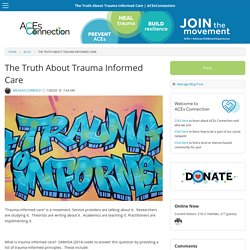
Service providers are talking about it. Researchers are studying it. Theorists are writing about it. Childhood Trauma Leads to Brains Wired for Fear. Negative childhood experiences can set our brains to constantly feel danger and fear says psychiatrist and traumatic stress expert Bessel van der Kolk.
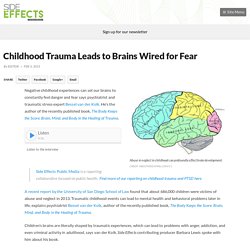
He's the author of the recently published book, The Body Keeps the Score: Brain, Mind, and Body in the Healing of Trauma. Listen to the interview Side Effects Public Media is a reporting collaborative focused on public health. Dr. Christine Courtois on Trauma Bonding. The Truth About Trauma Informed Care. "I need you to...": Stepping into the shoes of a child who has experienced trauma, loss & change. This blog is going to be written from the perspective of a child or young person who has experienced trauma, loss and/or significant change.

How Trauma Lodges in the Body. March 9, 2017.
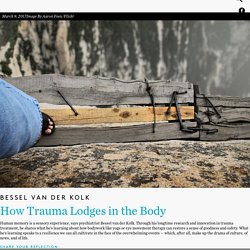
Developmental-Trauma-Close-Up-Revised-Jan-2020. The Field Guide for Barefoot Psychologists – Beyond Conflict. Creating a New Narrative of Mental Health Right now, there are approximately 68.5 million people displaced around the world, including over 10 million Syrians dislocated by war.
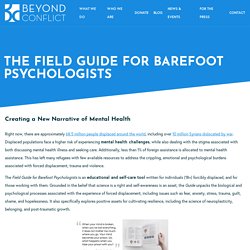
Displaced populations face a higher risk of experiencing mental health challenges, while also dealing with the stigma associated with both discussing mental health illness and seeking care. Additionally, less than 1% of foreign assistance is allocated to mental health assistance. This has left many refugees with few available resources to address the crippling, emotional and psychological burdens associated with forced displacement, trauma and violence. The Field Guide for Barefoot Psychologists is an educational and self-care tool written for individuals (18+) forcibly displaced, and for those working with them. Teaching Science Through Stories Importantly, the science covered in the Field Guide is introduced through storytelling. “I Like to Move It, Move It!” – How Dance and Rhythm Can Redu... If you’ve watched “Madagascar,” you’re sure to have seen King Julien leading the jungle in a rousing chant of “I Like to Move It, Move It” while doing just that.
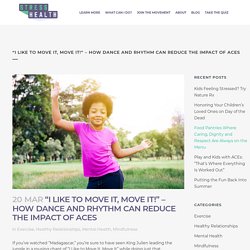
It turns out King Julien was onto something. If the iconic lemur were a scientist, he might have written a dazzling paper on what our ancestors already knew: Dance can help heal what ails you. As it is, more and more researchers are studying the healing power of rhythmic movement on people who’ve experienced trauma from Adverse Childhood Experiences (ACEs), such as abuse, neglect, or parental mental illness or substance abuse issues. Among these researchers is Dr. Neurodiversity and Fight-or-flight Response: How Occupational Therapy Saved M...
This week’s blog is dedicated to my occupational therapist — words cannot express my gratitude for guiding me through my pain and for helping me learn to regulate my nervous system; our work has changed my life — and to a special young man I had the pleasure of meeting this week — may you begin to see your true self, work to forgive yourself and learn to love yourself; I hope you feel better very soon.
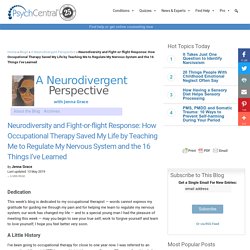
I’ve been going to occupational therapy for close to one year now. I was referred to an occupational therapist (OT) by a psychiatrist because, after over 20 years of seeking help and trying everything to get better, while there were slight improvements in my well-being, something was still extremely wrong. Every day was a struggle. I was easily overstimulated. How Trauma Can Damage the Brain for Generations and Can Be Reversed - The Best Brain Possible. The relatively new science of epigenetics is proving that who you are is the culmination of the experiences in your life – and even those of your ancestors – which cause changes in how your genes operate.

Modifications occur and genes can switch on or off depending on the environment. In other words, you are born with a certain set of genes, but the events of your life determine which genes get expressed and which genes don’t. The bad news is that trauma can be inherited through epigenetic changes and a multitude of illnesses, behaviors, and health issues have been linked to epigenetic mechanisms. Time. In May, now-ousted U.S.

Attorney General Jeff Sessions announced the start of the Trump Administration’s “zero tolerance” policy to separate migrant families at the Mexican border. “If you are smuggling a child” into the country, he said, “then we will prosecute you, and that child will be separated from you as required by law.” In just six weeks, more than 2,600 children were taken from their parents or other adults. Although a federal judge ordered the government to reunite all children with their families by July 26, hundreds likely still remain in U.S. custody. The Truth About Trauma Informed Care. 7 Subtle Signs Your Trauma Response is to ‘Fawn’ – Let's Queer Things Up! Last month, I wrote about the fourth type of trauma response — not fight, flight, or even freeze, but fawn.
The term was first coined by therapist and survivor Pete Walker, who wrote about it in his groundbreaking book “Complex PTSD: From Surviving to Thriving.” And let me tell you, as a concept, it thoroughly changed the game for me. In a nutshell, “fawning” is the use of people-pleasing to diffuse conflict, feel more secure in relationships, and earn the approval of others. Opinion: Screenings Alone Won’t Prevent Adverse Childhood Experiences—We Must... Earlier this month, California’s Surgeon General Nadine Burke Harris launched an ambitious campaign to reduce adverse childhood experiences, which can cause lifelong health problems.
With more than 60 percent of Californians saying they were exposed to a traumatic childhood event, adverse childhood experiences are at crisis levels in the state. The ACEs Aware campaign will train and pay health care providers to screen Medi-Cal recipients for adverse childhood experiences, known as ACEs. This investment in screenings is a first step for the surgeon general, who is also a pediatrician, in achieving her visionary goal to reduce adverse childhood experiences by 50 percent in a generation. Reducing ACEs will improve health and wellbeing across the state. The Spirit Guide on Instagram: “Facts □ @the_spiritguide_” An Early Childhood Development Expert Explains How Trauma and Stress Can Dera... Mimi Graham has spent her life fighting for kids. She began her career in the late 1970s as a Head Start administrator before moving into the world of academia to study child development and advocate for public policies that improve the health of mothers and children.
Today, she’s the director of Florida State University’s Center for Prevention & Early Intervention Policy, a position in which she advises government agencies and nonprofits all around the state, including Sarasota. Trauma, Attachment, and Relationships. Interventions in the Attachment and Relationship Problems Trauma Can Cause Julie De Wilde Alfred Adler Graduate School Abstract Much research has been done on the negative effects of trauma on attachment, which then has negative effects on relationships. Research more recently has focused on the positive post traumatic growth that can happen when clients receive safe, healthy attachment to a therapist they can trust. Episode 1105: Dr. Bruce Perry. Day Two - Childhood Trauma Conference - Lisa Cherry. Childhood Trauma Can Impact Our Gut Bacteria. A Columbia University study has found that adversity early in life is associated with increased gastrointestinal symptoms in children that may have an impact on the brain and behavior as they grow to maturity.
The Repair of Early Trauma: A Bottom Up Approach. Peter Levine’s Felt Sense Exercise – The Art of Healing Trauma. I read the book Waking the Tiger by Peter Levine back in 2009 and then from October 2010 until December 2011 had sessions with an excellent Somatic Experiencing therapist to address symptoms of PTSD (Somatic Experiencing is the somatic therapy developed by Peter Levine).
A central component of Somatic Experiencing is the “felt sense.” The felt sense is the embodiment (bringing awareness inside the body) of one’s ever-changing sensory/energetic/emotional landscape. The felt sense moves our focus from actions and things happening outside us in the world to qualities of our present, internal experience (e.g. textures, colors, sensations).
Bessel van der Kolk on the Treatment of Trauma: How Childhood Trauma is Diffe... Trauma and the Brain. Why Trauma Survivors Can’t Just ‘Let It Go’ 4 Cognitive Distortions Caused By Childhood Emotional Neglect – Fighting for a Future. The Compulsion to Repeat the Trauma. During the formative years of contemporary psychiatry much attention was paid to the continuing role of past traumatic experiences on the current lives of people. 39 217 5 PB. Trauma: Frozen Moments, Frozen Lives. "I can't remember anything after the first few words she said: 'I'm sorry to tell you that your test results came back positive.' Childhood Trauma Leads to Brains Wired for Fear. Negative childhood experiences can set our brains to constantly feel danger and fear says psychiatrist and traumatic stress expert Bessel van der Kolk. The Trauma Disorder You May Not Have Heard About.
Understanding Trauma: Learning Brain vs Survival Brain. The PTSD brains of children and soldiers. What Is Developmental Trauma? What Every New Social Worker Needs To Know...Trauma Informed Care in Social W... By Elisa Kawam, Ph.D., and Marcos J. Nine Ways To Ensure Your Mindfulness Teaching Practice Is Trauma-Informed. People-pleasing can be a result of trauma. It’s called ‘fawning’ — here’s how... Intergenerational Trauma Is a Biological Reality. In Lesbos’s Moria camp, I see what happens when a child loses all hope. The Window of Tolerance Animation by Beacon House. Gaskill.